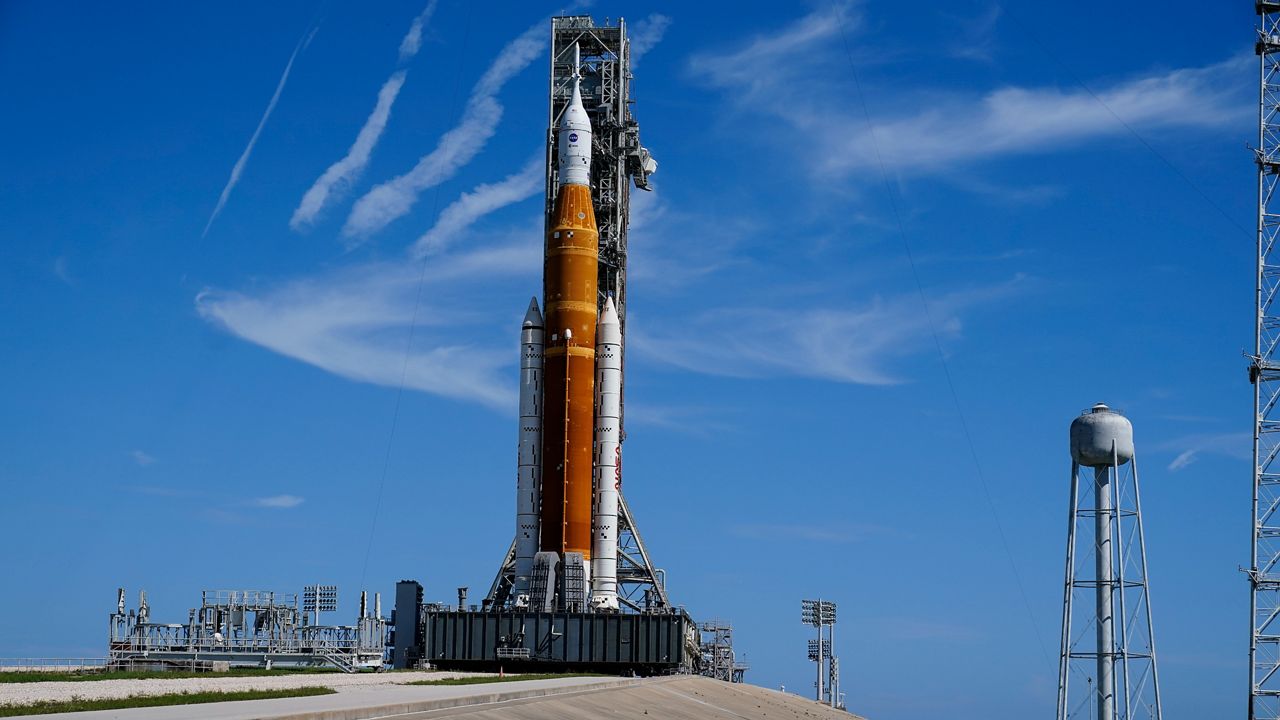KENNEDY SPACE CENTER — The Artemis launch for Saturday has been scrubbed.
Despite engine-related issues and a hydrogen leak that forced the scrubbing of a first attempt, another attempt was set for Saturday. Another, but separate, hydrogen leak caused concerned officials to call off the launch.
What You Need To Know
- Saturday’s Artemis launch attempt has been scrubbed
- RELATED cover:
Saturday’s postponed launch comes days after the first attempt Monday was scrubbed over a separate hydrogen leak.
The space agency has had three press briefings since it had to scrub Monday’s launch attempt of the Artemis I’s Space Launch System (SLS) rocket and the Orion capsule due to engine issues and a leak. In fact, Monday’s two-hour launch window was set to open at 8:33 a.m. EDT, but those issues forced NASA to place a hold and eventually scrub the mission at 8:35 a.m. EDT.
During Tuesday’s teleconference, Artemis Mission Manager Mike Sarafin said the launch would go ahead on Saturday, and he addressed some of the issues that plagued NASA’s engineers.
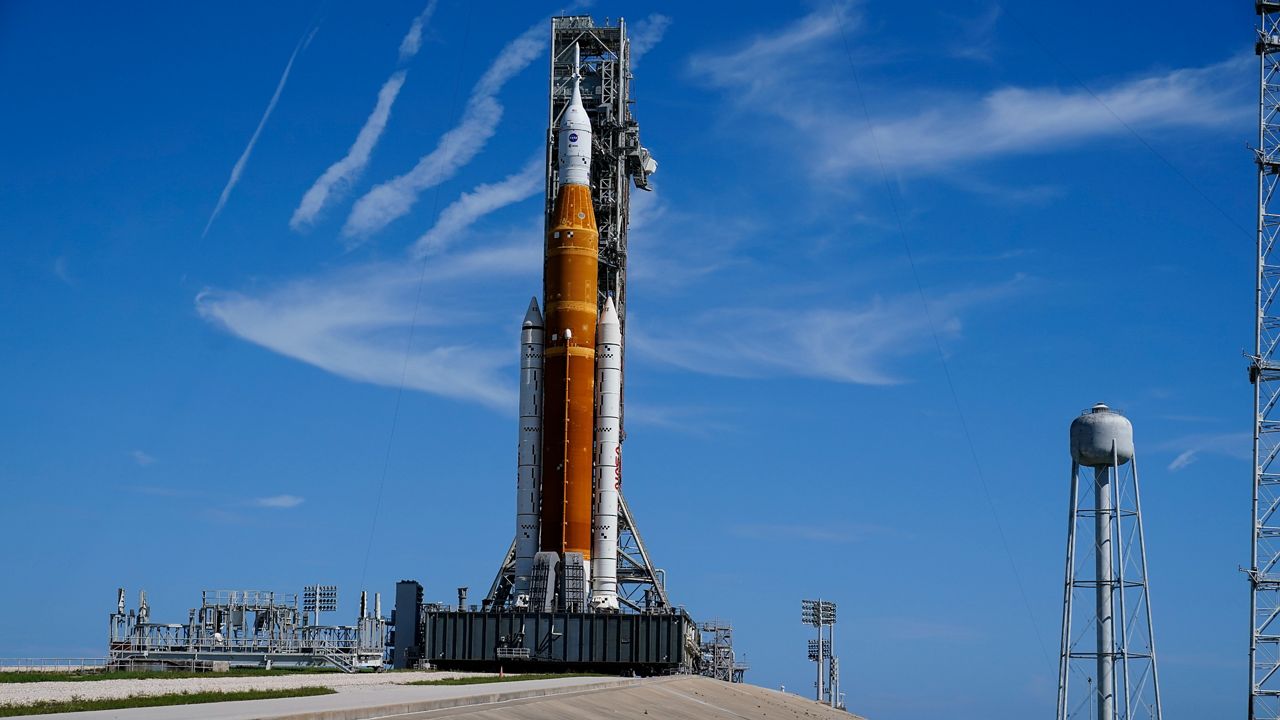
The SLS rocket launch scheduled for Saturday was postponed. (AP/Brynn Anderson)
As the rocket and capsule sat on Launch Pad 39B at the Kennedy Space Center, NASA teams were unable to chill down the rocket’s four RS-25 engines to about minus 420 degrees Fahrenheit, with engine 3 displaying higher temperature readings than the others.
The engines need to be thermally conditioned before they can receive the subzero fuel.
The Space Launch System rocket needs 730,000 gallons of super-cooled liquid hydrogen and liquid oxygen for liftoff.
Sarafin said a team of engineers addressed that issue, as well as the leak at the tail service mast umbilical on the hydrogen side of the rocket. He added, during a separate Thursday evening briefing, that engineers worked on and successfully repaired the leak.
NASA explained that its teams of engineers replaced a flex hose and a loose pressure sensor line, which the agency believes was the source of the leak, and tightened “bolts surrounding that enclosure to ensure a tight seal when introducing the super-cooled propellants through those lines.”
Sarafin said they have also “worked through a number of issues.”
Sarafin also said that there are two risk acceptance: the thermal conditioning of the engines and the cracks in the foam of the thermal protection system on the core stage at the intertank flange.
He said there is a risk that those two items may cause issues, but said NASA is comfortable with their risk acceptance.
“It is a low likelihood occurrence, but something we consider an acceptable risk,” he said.
But despite the risks, Sarafin said NASA is preparing for a Saturday launch.
“We are setting up for a launch attempt on Sept. 3, Saturday,” he said. ” … there is no guarantee we are going to get off on Saturday but we are going to try.”
Not too shabby of a view on the way out either! #Artemis #SLS #Orion @MyNews13 pic.twitter.com/3MgZeEAImy
— Will Robinson-Smith (@w_robinsonsmith) September 1, 2022
NASA will also be chilling down the engines to about 30 to 45 minutes earlier in the countdown during the liquid hydrogen fast-fill phase of the rocket. This will give NASA more time to cool the engines to the right temperatures for launch and in case the threat of nearby storms will push back the fueling of the rockets, as it did on Monday.
Melody Lovin, a Space Launch Delta 45 weather officer, also said on Friday as she did the night before that there is a 60% chance of favorable weather for Saturday’s launch but stressed that there is a threat of storms near the shoreline. Both a cumulus cloud rule and anvil cloud rule are in place.
She explained the rocket cannot fly into an active thunderstorm and cannot trigger its own lightning — the anvil rule. She said that can happen when rockets fly into a cloud, through a spread of electrical currents in the atmosphere.
However, Lovin said the weather looks “pretty good” for launch time, with the two-hour window opening at 2:17 p.m. EDT.
If for whatever reason the launch is pushed back, Parsons said the next attempt would be on Monday, with a 90-minute launch window opening at 5:12 p.m. EDT.
A second chance
NASA was hoping all would go well for its second shot at lifting off the Artemis I’s Space Launch System rocket and the Orion spacecraft, still currently sitting on the launch pad.
Mission specs:
- Space Launch System rocket: 322 feet tall
- Rocket fuel: 730,000 gallons of super-cooled liquid hydrogen and liquid oxygen
- Orion: 10 feet, 11 inches tall and 16.5 feet in diameter
- Mission Duration: 37 days, 23 hours, 53 minutes (it was originally 42 days, 3 hours, 20 minutes before the scrub)
- Total mission distance: About 1.3 million miles
Understanding Artemis I mission
The Artemis program has three missions: Artemis I, Artemis II and Artemis III.
Artemis I is an uncrewed test flight that is designed to provide NASA with information that will be utilized for the two later missions.
Some of the tests that the Artemis I mission will conduct are: getting to the moon, orbiting the Earth’s lunar sister and returning home to test its heat shields and parachutes — because eventually astronauts will be in an Orion capsule and they will want a soft landing.
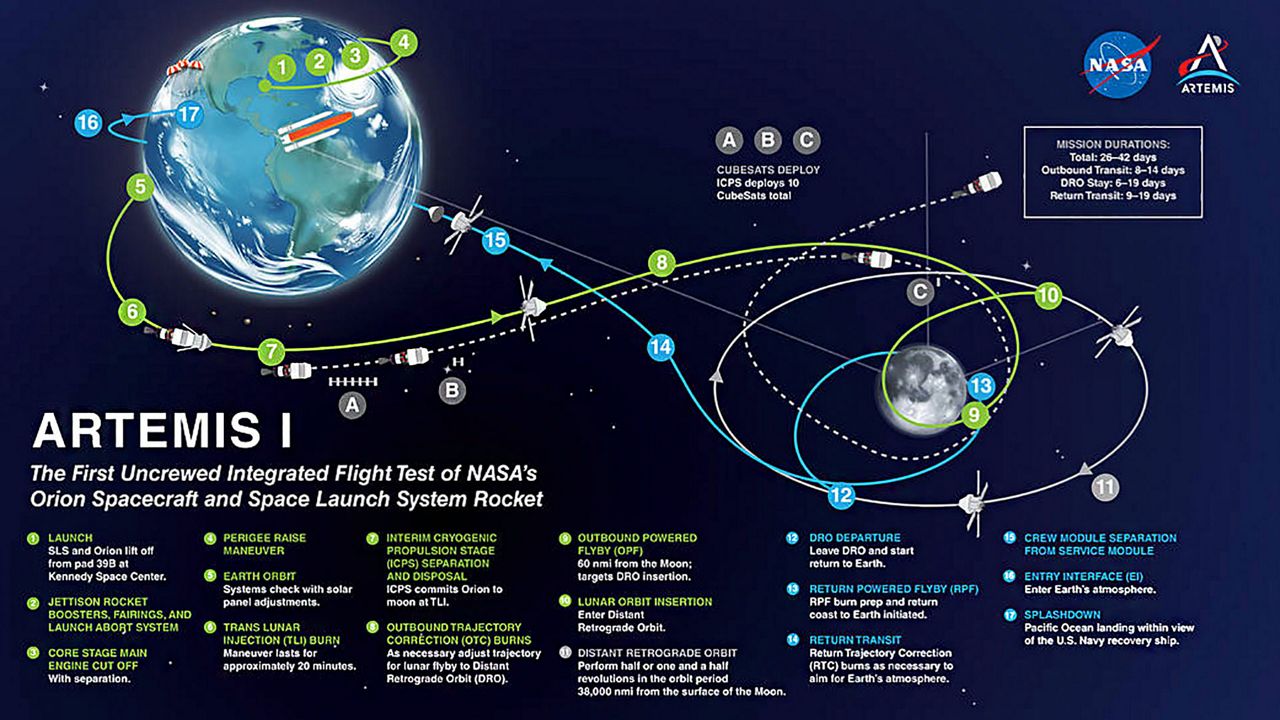
(Graphic courtesy of NASA)
Once Orion is launched, it will orbit the Earth to gather enough speed to break free from the planet’s gravitational pull and head to the moon. But to do that, Orion will use its own rockets (called the interim cryogenic propulsion stage, which is a modified United Launch Alliance’s Delta cryogenic second stage).
As Orion undertakes its days-long journey to the moon, NASA engineers will evaluate the spacecraft’s systems to make sure everything is operating as expected.
While NASA is calling the Artemis I mission uncrewed, in the strictest technical sense, that is not entirely accurate. Cmdr. Moonikin Campos — while not a living person — will be in the commander’s seat, and as an unofficial crew member, will play a big role in the mission.
Decked out in a spacesuit and sensors, the “commander” will record the acceleration and vibrations of the launch and mission, plus take radiation measurements as the spacecraft flies through space.
As the brave commander heads to its destination, the engineers on Earth will continue to monitor the Orion craft as it approaches and orbits the moon, stationed about 60 miles above the lunar surface during its closest approach, NASA officials say.
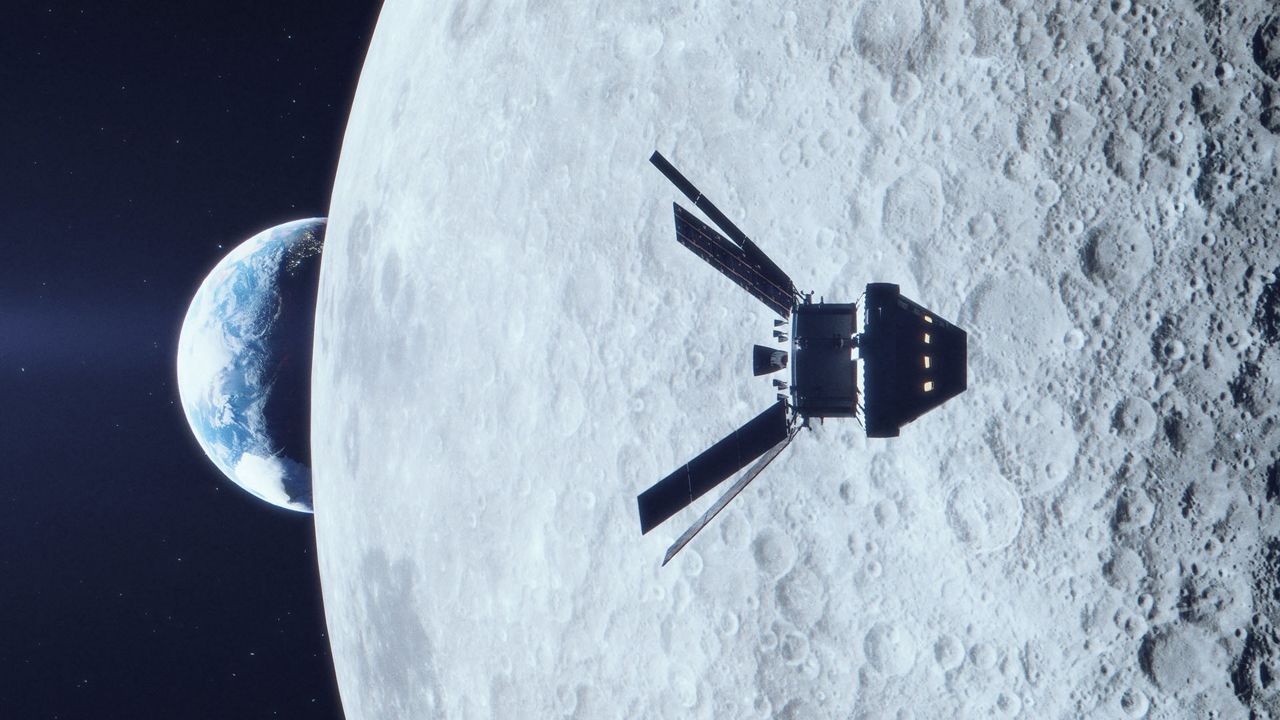
In this artist rendition, the Orion spacecraft will orbit the moon during the Artemis I mission. NASA named the mission to return to Earth’s lunar neighbor Artemis, as a homage to the Apollo moon landing. In Greek mythology, Artemis is the twin sister of Apollo and the goddess of the moon. (NASA)
Using the moon’s gravitational force, Orion will be thrust into a distant retrograde orbit, meaning it will go about 40,000 miles past the moon. Experts say, if successful, that will be quite an achievement.
“This distance is 30,000 miles farther than the previous record set during Apollo 13, and the farthest in space any spacecraft built for humans has flown,” information from NASA stated.
When ready to embark on its return trip, the spacecraft, which can hold up to four astronauts, will use the moon’s gravity to slingshot itself back to Earth before firing its rockets.
When Orion does return home, it will be traveling at speeds up to 25,000 mph before the Earth’s atmosphere slows it down to a mere 300 mph.
And therein lies one of the most important tests of the mission: The speed of returning to Earth. As Orion is speeding along at 300 mph, NASA expects it to produce temperatures of about 5,000 degrees Fahrenheit on the craft itself. This will test the craft’s heat shield’s performance, NASA stated.
“Our first and our primary objective is to demonstrate Orion’s heat shield at lunar re-entry conditions. So we want to demonstrate that it can withstand the high speed and high heat that the spacecraft will encounter when it re-enters the Earth’s atmosphere,” said Artemis Mission Manager Mike Sarafin during a teleconference back in July.
The splashdown into the Pacific Ocean off the coast of San Diego is expected to happen on Oct. 10.
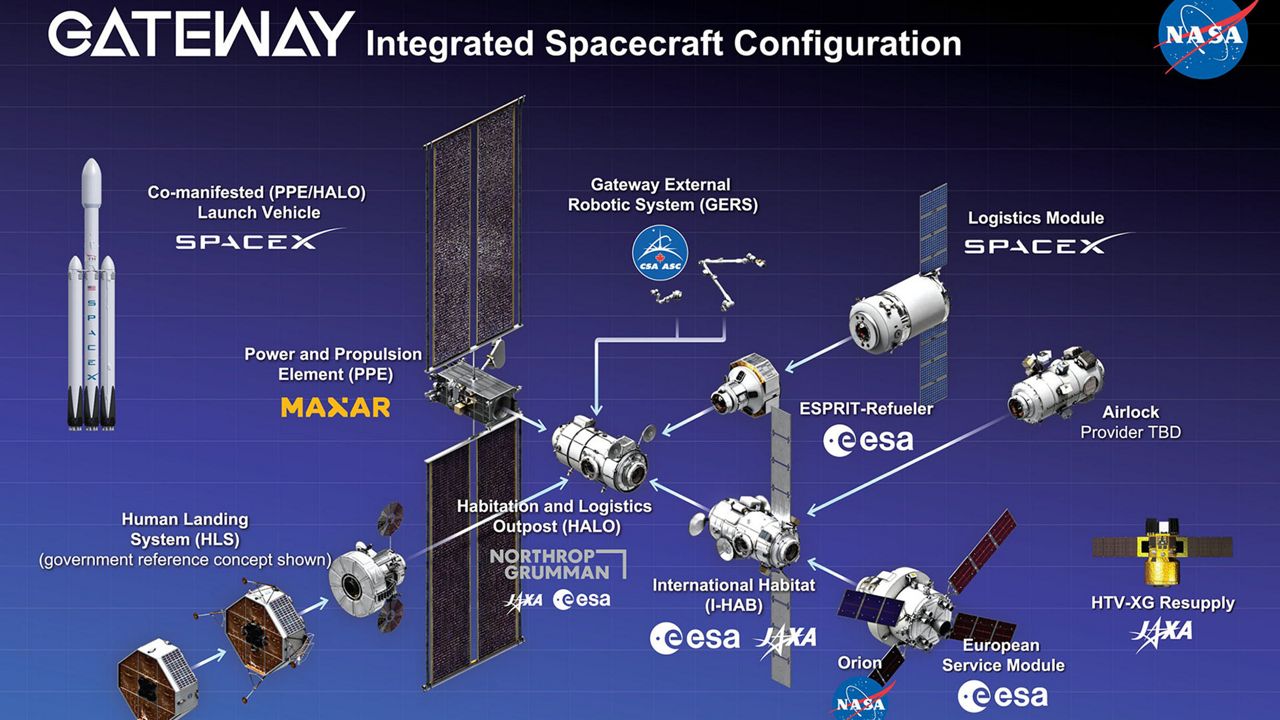
“Gateway will be humanity’s first space station in lunar orbit to support NASA’s deep space exploration plans, along with the Space Launch System (SLS) rocket, Orion spacecraft, and the Human Landing System (HLS) that will send astronauts to the moon,” NASA described. (NASA)
The other Artemis missions and the future
As scientists and engineers unwrap the findings of the Artemis I mission, they will begin to pave a way for future crewed missions.
In 2024, the plan is for Artemis II astronauts to do a flyby of the moon. Using data from that mission, in 2025, Artemis III will send humans back to the surface of the moon.
In fact, during Artemis III, it is expected that the world will see the new Gateway space station in action, which should be orbiting the moon by then.
Being built by both international and commercial partnerships, the Gateway will provide exploration and research support and a place for astronauts to live. But it will not just be for lunar visits — space agencies plan to use it to help with missions to Mars in the coming years.

